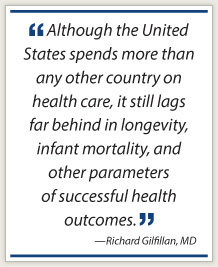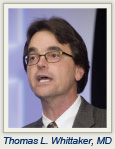The Association of Community Cancer Centers (ACCC) mid-March Annual Meeting devoted several sessions to the Patient Protection and Affordable Care Act: Will it still be here after the Supreme Court decides its fate? If so, how much of it will survive, and how will it affect oncology practice?
In late March, the Supreme Court heard an almost unprecedented 6 hours of arguments over 3 days about the constitutionality of the law, based primarily on Florida’s assertion that Congress cannot mandate that individuals purchase and maintain health insurance (25 other states agree). The justices may rule as soon as mid-June, or they may postpone their decision until 2014 when the law will take effect.
CMS and Innovation
 The Centers for Medicare & Medicaid Services (CMS) are front and center of how the Affordable Care Act is implemented. Richard Gilfillan, MD, Director of the CMS Innovation Center, said, “CMS is planning new engines to revitalize and sustain Medicare and play an even greater role in the lives of providers and patients. We have the will to change and we will do what the country needs.”
The Centers for Medicare & Medicaid Services (CMS) are front and center of how the Affordable Care Act is implemented. Richard Gilfillan, MD, Director of the CMS Innovation Center, said, “CMS is planning new engines to revitalize and sustain Medicare and play an even greater role in the lives of providers and patients. We have the will to change and we will do what the country needs.”
The Affordable Care Act funds the Innovation Center, which was established to find new and better ways to provide health care to the growing number of Medicare and Medicaid beneficiaries.
He added that although the United States spends more than any other country on health care, it still lags far behind in longevity, infant mortality, and other parameters of successful health outcomes. “Our goals of better health, better health care, and lower costs remain to be achieved,” he said.
 CMS now pays for health care in expensive and inefficient fragments. “We should pay for coordinated care, and providers ought to deliver it. In other words, we need to come up with and test innovative payment and service delivery models that will decrease expenditures while preserving quality,” Dr. Gilfillan said.
CMS now pays for health care in expensive and inefficient fragments. “We should pay for coordinated care, and providers ought to deliver it. In other words, we need to come up with and test innovative payment and service delivery models that will decrease expenditures while preserving quality,” Dr. Gilfillan said.
This means that providers will have to be open to change as CMS provides new alternative payment models from which to choose.
Ten billion dollars has been appropriated for CMS over the next 9 years, which the agency will use to streamline the way it does business, regardless of what the Supreme Court decides. “The system has to be changed regardless, and the funds are in the bank,” said Dr. Gilfillan.
Accountable Care Organizations
One major innovation is accountable care organizations—groups of providers giving coordinated care to Medicare patients. “The purpose is to give the right care at the right time while avoiding unnecessary duplication of services and preventing medical errors. [Accountable care organizations] are designed to save money and will share those savings with Medicare,” explained Dr. Gilfillan. And there is more than one way to run an accountable care organization program.
The Advance Payment Model will test whether and how prepaying a portion of anticipated costs could increase participation in the Medicare Shared Savings Program. Provider organizations would receive an advance on anticipated shared savings as a monthly stipend for each Medicare beneficiary. There has been interest in the program, but some providers are concerned about being able to afford the required infrastructure and staff.
The Pioneer Model will be used with providers already experienced in coordinating patient care. It allows groups to move rapidly from a shared payment model to a population-based one on a track separate from the Shared Savings Program. It is designed to coordinate with private payers, which should improve quality and health outcomes, as well as save money for everyone.
The ‘Medical Home’ Concept
“Medical home” is a buzzword engendered by the Affordable Care Act and is defined as the coordination of comprehensive care by primary providers, the oncology team, and accountable care organizations. Its primary goal is to improve outcomes. According to a survey conducted by the ACCC, 63% of administrators, oncologists, and oncology nurses who work in a hospital-based cancer program believe that an oncology medical home model could work in their practices (see related story on page 38).
 Almost half the respondents were worried about start-up costs and negotiations with payers, but some thought that a medical home could provide better quality collaborative care at lower cost. Half said that they don’t anticipate their practice or hospital becoming part of a medical home within the next 2 years because they don’t foresee a shift away from the traditional “buy and bill” model. The other half think that moving away from traditional billing practices can result in improved patient care.
Almost half the respondents were worried about start-up costs and negotiations with payers, but some thought that a medical home could provide better quality collaborative care at lower cost. Half said that they don’t anticipate their practice or hospital becoming part of a medical home within the next 2 years because they don’t foresee a shift away from the traditional “buy and bill” model. The other half think that moving away from traditional billing practices can result in improved patient care.
Thomas L. Whittaker, MD, ACCC President, said “there is tremendous value in strong connections between oncology and primary care and in educating the entire oncology community about the structure and benefit of the oncology medical home. I believe it could fit nicely into an [accountable care organization], carving out the oncology care and ownership of that care. Medical home and [accountable care organizations] can complement each other.”
Bundled Payments
The CMS Bundled Payments for Care Improvement initiative will combine payments for services delivered across one episode of care—for example, heart bypass or cancer diagnosis and treatment—rather than paying for each service separately. Bundled payments will give providers incentives to coordinate care, improve quality, and save money for Medicare, said Dr. Gilfillan. It also can reduce duplication of services and medical errors, help patients heal without harm, and lower costs.
When payment is bundled, CMS will create a “package” of services for a specific condition, such as a hospital stay and its recovery. “Providers will have the flexibility to determine which episodes of care and which services will be bundled. Thus, they can choose what works best for them based on the size and characteristics of their practice. We are responding to an overwhelming need on the part of hospitals and physicians for a flexible approach to patient care improvement. Already, many health-care institutions have implemented this initiative with positive results,” said Dr. Gilfillan.
Sharp Divide on Health-care Improvement
 “The current system of providing health care in this country is rife with bad outcomes,” said Deborah E. Trautman, PhD, RN, Executive Director, Center for Health Policy and Healthcare Transformation, Johns Hopkins Medicine. “It’s expensive, ineffective, and unjust,” she said.
“The current system of providing health care in this country is rife with bad outcomes,” said Deborah E. Trautman, PhD, RN, Executive Director, Center for Health Policy and Healthcare Transformation, Johns Hopkins Medicine. “It’s expensive, ineffective, and unjust,” she said.
Almost everyone agrees that there’s a serious problem, but there is little agreement about solutions and what, if anything, the Affordable Care Act can do to improve things.
Many people, including health-care providers, do not fully understand what is in the 900+ page legislation. In essence, it aims to make health insurance more accessible and affordable, enabling 32 million more people to purchase health care coverage in the United States. Approximately 50 million people in the United States do not have health insurance, according to a U.S. Census Report issued in 2010. Other provisions include:
- Dependent children remaining on their parents’ plans until age 26
- Making insurance carriers justify a rate hike of 10% or more per year
- Requiring that at least 80% of insurance premiums be spent on health care rather than on administrative costs and advertising
- Removal of lifetime benefit limits and a ban on exclusion for preexisting conditions
- Increased access to free preventive services
- An increase in the number of health-care providers
- A major effort to crack down on Medicare and private insurance fraud
- Ease of access to state health insurance exchanges, 13 of which have already been established and 5 of which are in progress
- Coverage of essential health benefits, a comprehensive package of items and services, such as ambulatory care, emergency services, hospitalization, mental health and substance abuse treatment, chronic disease management, and others.
“The health-care reform train has left the station, and we are going to be at this for quite some time,” said Dr. Trautman. She added that the United States is a nation divided about what to do, much of which is due to lack of information. For example, according to a Kaiser Health Tracking Poll from last year,1 22% of Americans thought the Affordable Care Act had already been repealed, and another 26% did not know what its legal status was.
The federal government is not the only stakeholder in this endeavor. “Much will be happening at the local level, and there is a lot of opportunity for health professionals to have their voices heard,” Dr. Trautman said. ■
Disclosure: Dr. Gillifan, Whittaker, and Trautman reported no potential conflicts of interest.
Reference
1. Henry J. Kaiser Family Foundation: Kaiser Health Tracking Poll, February 2011. Available at http://www.kff.org/kaiserpolls/upload/8156-F.pdf. Accessed March 21, 2012.

